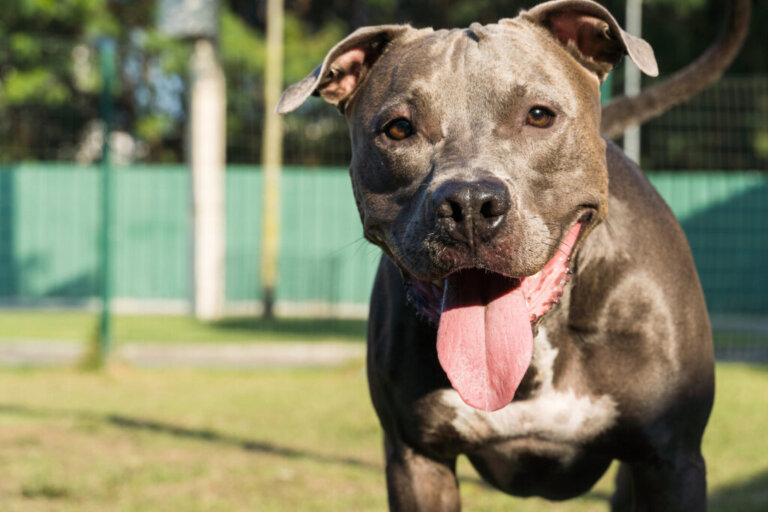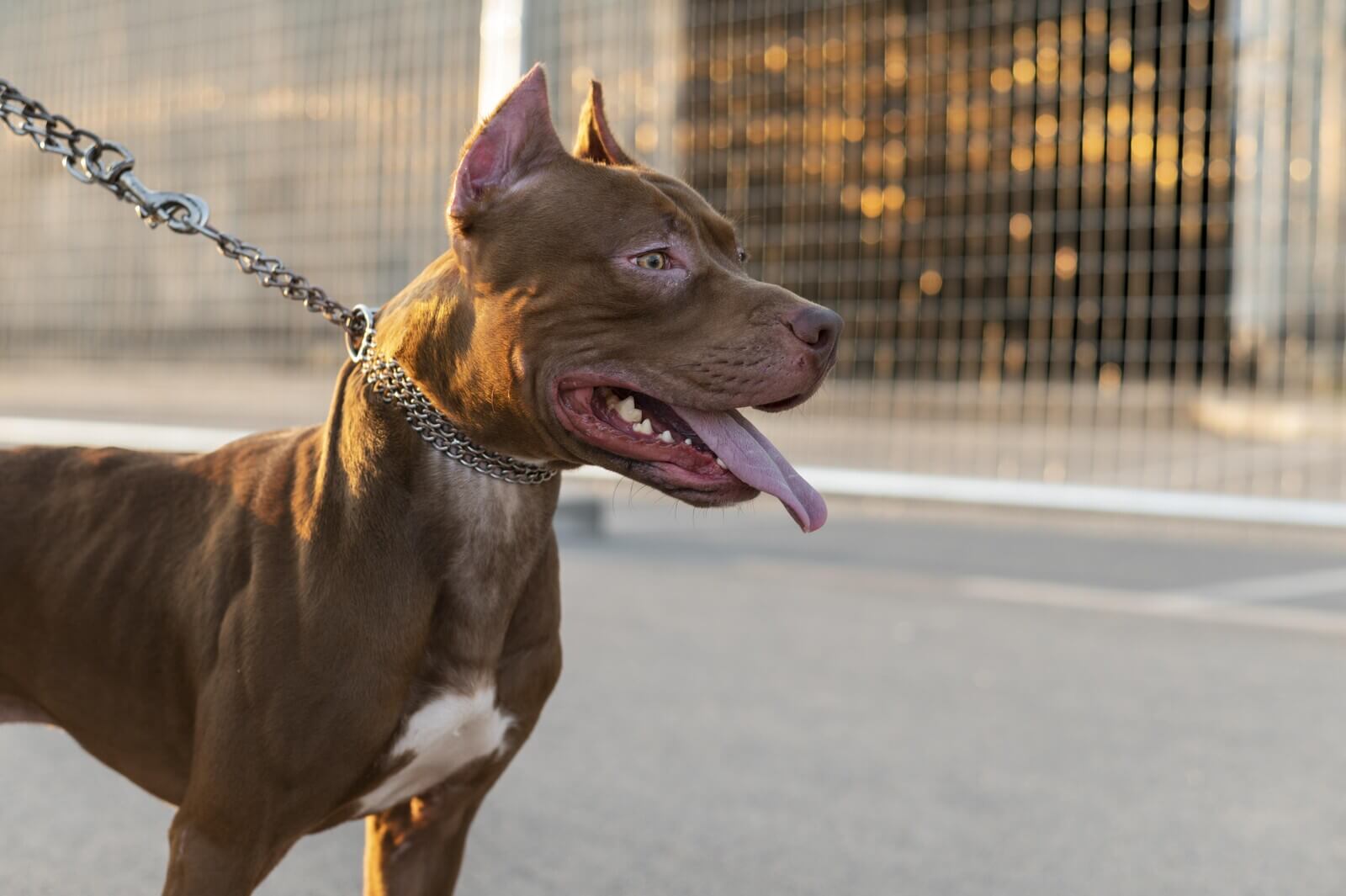The Relationship Between Pit bulls and Other Dogs: What You Should Know


Written and verified by the psychologist Sara González Juárez
There are many myths about how pit bulls relate to other dogs and animals, including humans. However, their dangerous appearance is nothing more than the result of crossbreeding created by man for very sad purposes. It has nothing to do with the real temperament of this breed.
Even so, they’re dogs with incredible strength and can be problematic when it comes to socialization if they’re not properly educated. Therefore, in this article, you’ll find useful information that will help your pit bull – or the one you’re thinking of adopting – relate in a positive way with other animals. Don’t miss a thing!
The origin of the pit bull
To better understand the pit bull’s temperament, you need to know the origin of its name. The truth is that it’s a sad story, as it refers to the confrontation of bulls with dogs.
When this practice -known as bull baiting- was abolished in 1835, dogs were put in pits to kill as many rats as possible in a short period of time. This is how the word pitbull was born, mixing references to the two horrible activities to which they were subjected.
However, the title pitbull actually refers to several typified breeds. According to the Journal of Applied Animal Welfare Science, the American pit bull terrier, the American Staffordshire Terrier, the American Bully, the Staffordshire Bull Terrier, and the American Bulldog are usually categorized as such. In the following paragraphs, we’ll get to know the temperament of these dogs a little better.
What is their personality like?
The myth that taints popular knowledge regarding pit bulls revolves around their supposed dangerousness and explosive temperament. However, this has nothing to do with reality: Any dog that’s raised to protect and attack will do so. Keep in mind that many acquire buy them in order to have an intimidating “accessory” by their side when they walk.
What’s true is that, due to constant artificial crossbreeding for aggressive dogs, this breed tends to be dominant and somewhat reactive. There’s also a certain inclination to be suspicious of strangers and overprotective of the family. In spite of this, a recent paper in BMC Genomics reported that genetic inheritance alone doesn’t explain aggressive behavior in these dogs.
The latter is because pit bulls establish very strong bonds with the other animals (human or otherwise) with which they live, so they tend to protect them from perceived threats.
They’re also intelligent animals and learn easily. Their bond with their family is strong, and they tend to live well with children and small animals. They have a lot of energy, so they’re perfect companions for an active life and many outdoor activities.

How to socialize pit bulls with other dogs
As they’re protective animals and are often wary of strangers, the socialization of pit bulls must be thorough and deep. In this section, we’ll highlight two fundamental aspects regarding pit bulls:
1. The preference for play “fighting”: Although this doesn’t imply that it wants to harm its playmate, accidents can occur when the other dog is smaller or your pit bull doesn’t know how to understand calm and avoidance signals.
2. A tendency to be overprotective: It’s possible that, in the beginning, your dog will tend to mark and reject other dogs during walks. It’s important to pay attention to these behaviors, as they could escalate into aggression.
Therefore, to help your pet socialize properly, you’ll need to interrupt interactions when they become aggressive or suspicious. However, never punish your canine, because apart from being unethical, it doesn’t work, and could even worsen aggressive reactions, as a group of researchers warns in a paper published in PLOS ONE.
Instead, you should reinforce every positive interaction with cuddles or treats.
Teach them the correct ways to interact, such as letting them sniff, playing with care, and avoiding confrontations. Ideally, you should do this from puppyhood. However, if a pit bull comes to you as an adult, don’t despair; their learning ability is still good.
Pit bulls with other dogs in the house
If a pit bull isn’t the first dog to enter the house, it’s normal to wonder if it’ll be able to get along with others of its species. As mentioned above, it’s wrong to assume that a dog of this breed will be aggressive, but it’s important to be alert to possible signs of territoriality and negative interactions.
As the Best Friends Animal Society reminds us, harmonious coexistence between two animals in a space -whatever their species- depends, to a large extent, on presentation. So, here are the general steps for the proper introduction of your new canine:
- Choose a neutral place to introduce them (inside or outside the house): A neutral place is defined as one in which neither of the two animals live and, therefore, doesn’t have their scent and belongings.
- Have them both on a leash (the first few times): Just the same, allow them to be free to sniff each other and get to know each other.
- Schedule short, frequent meetings: This way, they can get to know each other better.
- Remove both dogs from the space if there are negative interactions: Try not to reintroduce them until they calm down.
- Prolong the encounters over time: Do this until both animals are comfortable. Let the “host” dog invite the pit bull in.
- Reward your dogs’ good relationship: You can do this for a long time or, if you want, forever.
Additional tips regarding pit bulls and other dogs

To ensure a good relationship between a pitbull and other dogs, you have to take care of certain details of the nature of these canines. These are the most important ones:
- Educate your pitbull‘s bite: They’re animals with incredible jaw and neck strength. Redirect their biting behaviors to appropriate toys and teach them to play gently with other living creatures.
- Teach leash walking: A collar is insurance for emergency situations. However, it can also become a source of stress in socialization, so make sure you both learn to walk with her in a positive way.
- Promote your family’s learning: It’s not just the dog that has to learn to live with others. All family members, human or not, need to get to know one another and behave in a way that does not encourage or reinforce inappropriate behaviors.
- Schedule time for physical and mental exercise: Your pit bull will need play-filled walks and environmental enrichment at home (from toys to music). A study reported in Animals detailed that dogs show more relaxation behaviors when they have these entertainments. Therefore, they’re believed to reduce stress.
- Establish routines: Dogs need you to be consistent with your reinforcements. If you reward something one day and do the opposite the next, you’ll only cause confusion and hinder the learning process.
- Consult a professional: If you can’t get your pet to interact properly with other dogs, don’t hesitate to see a canine ethologist before the problem escalates and you have an accident.
Attention in order to avoid accidents
It should be noted that if the socialization of pit bulls with other dogs requires greater attention, it’s not because they’re aggressive or bad. Rather, it’s because accidents can be more serious than with other smaller breeds. You’ll be surprised how wonderful these animals can be!
There are many myths about how pit bulls relate to other dogs and animals, including humans. However, their dangerous appearance is nothing more than the result of crossbreeding created by man for very sad purposes. It has nothing to do with the real temperament of this breed.
Even so, they’re dogs with incredible strength and can be problematic when it comes to socialization if they’re not properly educated. Therefore, in this article, you’ll find useful information that will help your pit bull – or the one you’re thinking of adopting – relate in a positive way with other animals. Don’t miss a thing!
The origin of the pit bull
To better understand the pit bull’s temperament, you need to know the origin of its name. The truth is that it’s a sad story, as it refers to the confrontation of bulls with dogs.
When this practice -known as bull baiting- was abolished in 1835, dogs were put in pits to kill as many rats as possible in a short period of time. This is how the word pitbull was born, mixing references to the two horrible activities to which they were subjected.
However, the title pitbull actually refers to several typified breeds. According to the Journal of Applied Animal Welfare Science, the American pit bull terrier, the American Staffordshire Terrier, the American Bully, the Staffordshire Bull Terrier, and the American Bulldog are usually categorized as such. In the following paragraphs, we’ll get to know the temperament of these dogs a little better.
What is their personality like?
The myth that taints popular knowledge regarding pit bulls revolves around their supposed dangerousness and explosive temperament. However, this has nothing to do with reality: Any dog that’s raised to protect and attack will do so. Keep in mind that many acquire buy them in order to have an intimidating “accessory” by their side when they walk.
What’s true is that, due to constant artificial crossbreeding for aggressive dogs, this breed tends to be dominant and somewhat reactive. There’s also a certain inclination to be suspicious of strangers and overprotective of the family. In spite of this, a recent paper in BMC Genomics reported that genetic inheritance alone doesn’t explain aggressive behavior in these dogs.
The latter is because pit bulls establish very strong bonds with the other animals (human or otherwise) with which they live, so they tend to protect them from perceived threats.
They’re also intelligent animals and learn easily. Their bond with their family is strong, and they tend to live well with children and small animals. They have a lot of energy, so they’re perfect companions for an active life and many outdoor activities.

How to socialize pit bulls with other dogs
As they’re protective animals and are often wary of strangers, the socialization of pit bulls must be thorough and deep. In this section, we’ll highlight two fundamental aspects regarding pit bulls:
1. The preference for play “fighting”: Although this doesn’t imply that it wants to harm its playmate, accidents can occur when the other dog is smaller or your pit bull doesn’t know how to understand calm and avoidance signals.
2. A tendency to be overprotective: It’s possible that, in the beginning, your dog will tend to mark and reject other dogs during walks. It’s important to pay attention to these behaviors, as they could escalate into aggression.
Therefore, to help your pet socialize properly, you’ll need to interrupt interactions when they become aggressive or suspicious. However, never punish your canine, because apart from being unethical, it doesn’t work, and could even worsen aggressive reactions, as a group of researchers warns in a paper published in PLOS ONE.
Instead, you should reinforce every positive interaction with cuddles or treats.
Teach them the correct ways to interact, such as letting them sniff, playing with care, and avoiding confrontations. Ideally, you should do this from puppyhood. However, if a pit bull comes to you as an adult, don’t despair; their learning ability is still good.
Pit bulls with other dogs in the house
If a pit bull isn’t the first dog to enter the house, it’s normal to wonder if it’ll be able to get along with others of its species. As mentioned above, it’s wrong to assume that a dog of this breed will be aggressive, but it’s important to be alert to possible signs of territoriality and negative interactions.
As the Best Friends Animal Society reminds us, harmonious coexistence between two animals in a space -whatever their species- depends, to a large extent, on presentation. So, here are the general steps for the proper introduction of your new canine:
- Choose a neutral place to introduce them (inside or outside the house): A neutral place is defined as one in which neither of the two animals live and, therefore, doesn’t have their scent and belongings.
- Have them both on a leash (the first few times): Just the same, allow them to be free to sniff each other and get to know each other.
- Schedule short, frequent meetings: This way, they can get to know each other better.
- Remove both dogs from the space if there are negative interactions: Try not to reintroduce them until they calm down.
- Prolong the encounters over time: Do this until both animals are comfortable. Let the “host” dog invite the pit bull in.
- Reward your dogs’ good relationship: You can do this for a long time or, if you want, forever.
Additional tips regarding pit bulls and other dogs

To ensure a good relationship between a pitbull and other dogs, you have to take care of certain details of the nature of these canines. These are the most important ones:
- Educate your pitbull‘s bite: They’re animals with incredible jaw and neck strength. Redirect their biting behaviors to appropriate toys and teach them to play gently with other living creatures.
- Teach leash walking: A collar is insurance for emergency situations. However, it can also become a source of stress in socialization, so make sure you both learn to walk with her in a positive way.
- Promote your family’s learning: It’s not just the dog that has to learn to live with others. All family members, human or not, need to get to know one another and behave in a way that does not encourage or reinforce inappropriate behaviors.
- Schedule time for physical and mental exercise: Your pit bull will need play-filled walks and environmental enrichment at home (from toys to music). A study reported in Animals detailed that dogs show more relaxation behaviors when they have these entertainments. Therefore, they’re believed to reduce stress.
- Establish routines: Dogs need you to be consistent with your reinforcements. If you reward something one day and do the opposite the next, you’ll only cause confusion and hinder the learning process.
- Consult a professional: If you can’t get your pet to interact properly with other dogs, don’t hesitate to see a canine ethologist before the problem escalates and you have an accident.
Attention in order to avoid accidents
It should be noted that if the socialization of pit bulls with other dogs requires greater attention, it’s not because they’re aggressive or bad. Rather, it’s because accidents can be more serious than with other smaller breeds. You’ll be surprised how wonderful these animals can be!
All cited sources were thoroughly reviewed by our team to ensure their quality, reliability, currency, and validity. The bibliography of this article was considered reliable and of academic or scientific accuracy.
- Best Friends Animal Society. (s. f.). How to Stop Dog Mouthing. Consultado el 14 de junio de 2023. https://resources.bestfriends.org/article/how-stop-dog-mouthing
- Best Friends Animal Society. (s. f.). How to Introduce Dogs to Each Other. Consultado el 14 de junio de 2023. https://resources.bestfriends.org/article/how-to-introduce-dogs-each-other
- Bowman, A., Scottish, S. P. C. A., Dowell, F. J., & Evans, N. P. (2017). The effect of different genres of music on the stress levels of kennelled dogs. Physiology & Behavior, 171, 207-215. https://pubmed.ncbi.nlm.nih.gov/28093218/
- de Castro, A. C. V., Fuchs, D., Morello, G. M., Pastur, S., de Sousa, L., & Olsson, I. A. S. (2020). Does training method matter? Evidence for the negative impact of aversive-based methods on companion dog welfare. PloS One, 15(12), 22-50. https://www.ncbi.nlm.nih.gov/pmc/articles/PMC7743949/
- Hoffman, C. L., Harrison, N., Wolff, L., & Westgarth, C. (2014). Is that dog a pit bull? A cross-country comparison of perceptions of shelter workers regarding breed identification. Journal of Applied Animal Welfare Science: JAAWS, 17(4), 322–339. https://www.ncbi.nlm.nih.gov/pmc/articles/PMC4160292/
- Hunt, R. L., Whiteside, H., & Prankel, S. (2022). Effects of environmental enrichment on dog behaviour: Pilot study. Animals, 12(2), 141. https://www.mdpi.com/2076-2615/12/2/141/htm
- Olson, K. R., Levy, J. K., Norby, B., Crandall, M. M., Broadhurst, J. E., Jacks, S., Barton, R. C., & Zimmerman, M. S. (2015). Inconsistent identification of pit bull-type dogs by shelter staff. Veterinary Journal, 206(2), 197–202. https://pubmed.ncbi.nlm.nih.gov/26403955/
- Tang, J., & Arneja, J. S. (2018). Are Dog Bites a Problem of Nature or Nurture?. Plastic Surgery, 26(4), 297–298. https://www.ncbi.nlm.nih.gov/pmc/articles/PMC6236509/
- Zapata, I., Lilly, M. L., Herron, M. E., Serpell, J. A., & Alvarez, C. E. (2022). Genetic testing of dogs predicts problem behaviors in clinical and nonclinical samples. BMC Genomics, 23(1), 102. https://www.ncbi.nlm.nih.gov/pmc/articles/PMC8819838/
This text is provided for informational purposes only and does not replace consultation with a professional. If in doubt, consult your specialist.








